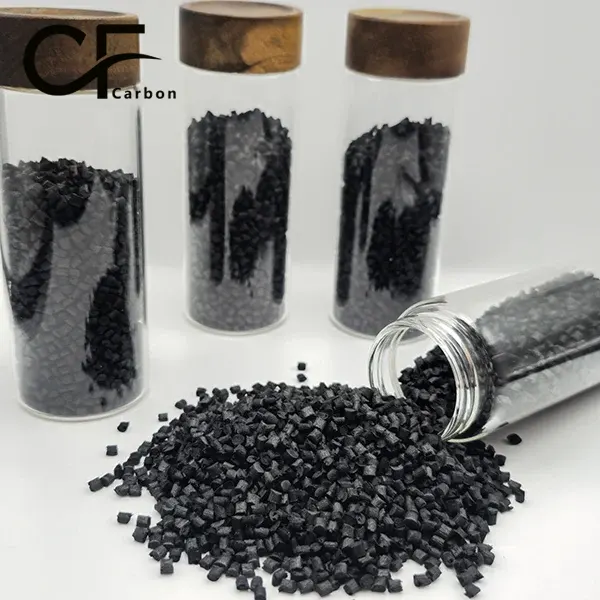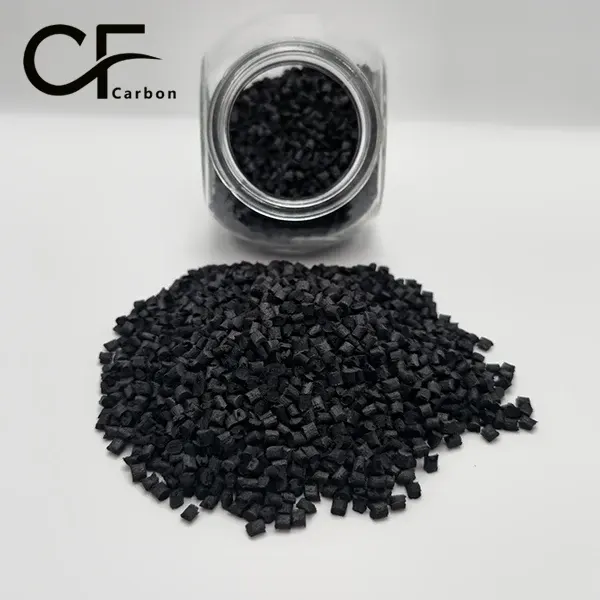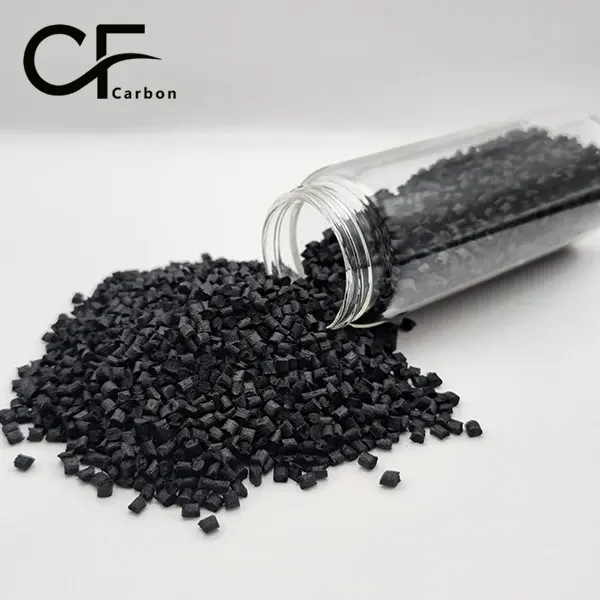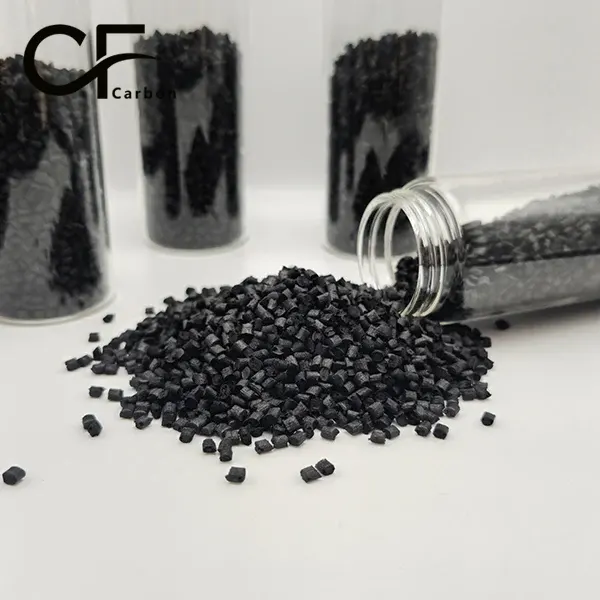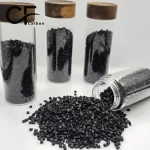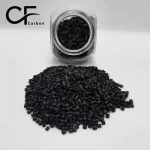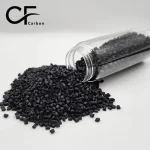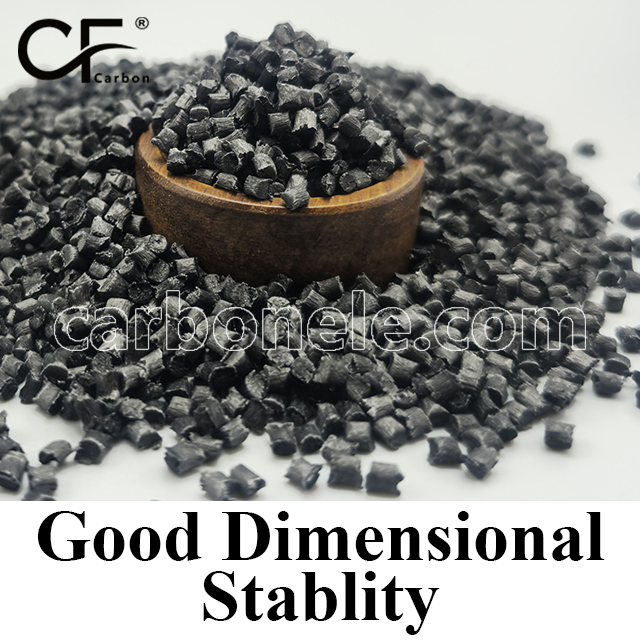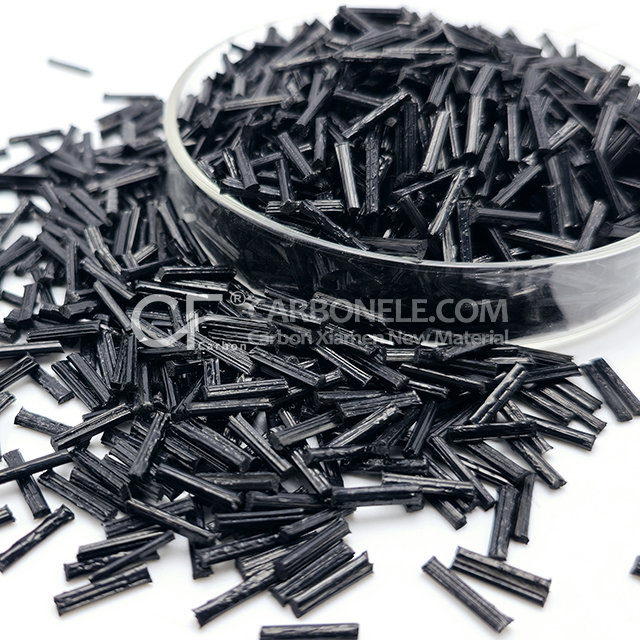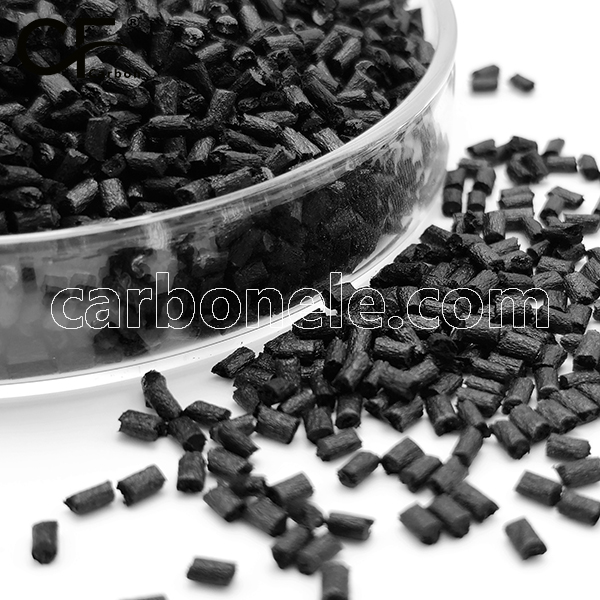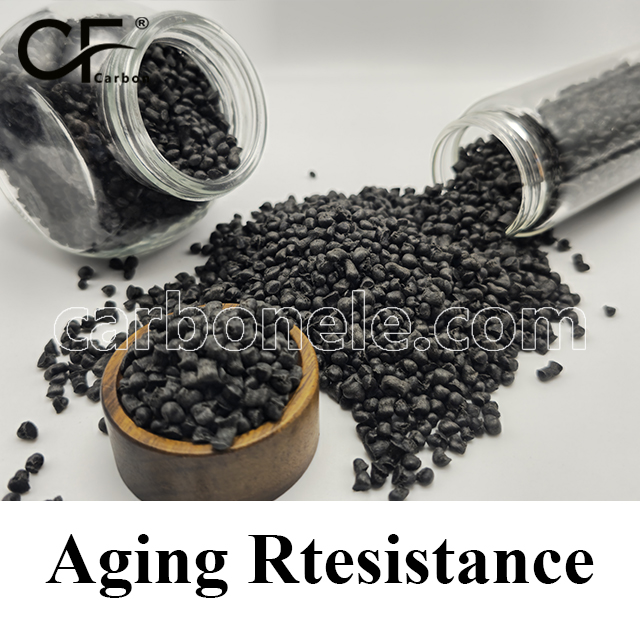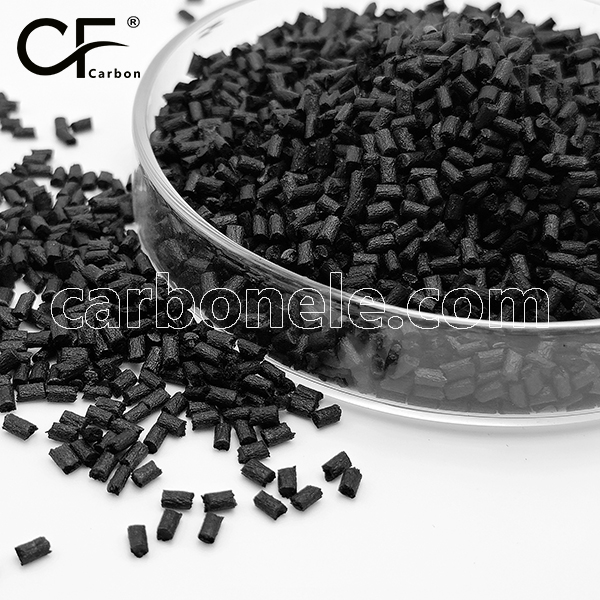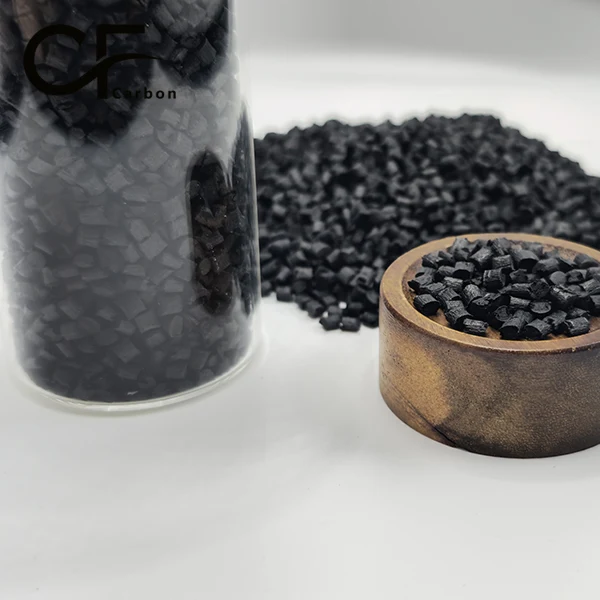
FR V Nylon Alloy CF PA66&PA6 CF20 Thermoplastic Granules
1: V-0 flame retardant grade certification
2: 220 MPa high tensile strength capacity
3: 260 MPa excellent flexural strength
4: 210°C heat deflection temperature rating
5: Over 10¹⁴ Ω surface resistivity
- Manufacturer: Carbon New Material
- OEM/ODM: Acceptable
- Color: Black
- Free samples: ≤10kg
- MOQ: 100kg
- Port: Xiamen
- Model: PA6&PA66-CF-BCF3
- Fillers: SCF
I. Material Overview
FR V Nylon Alloy CF PA66&PA6 CF20 is a flame retardant V-grade nylon alloy carbon fiber composite material, using a nylon 66 and nylon 6 alloy matrix with 20% carbon fiber and halogen-free eco-friendly flame retardants. This innovative FR V Nylon Alloy CF technology combines excellent flame retardancy with mechanical strength, achieving V-0 certification, providing safe and reliable solutions for electronics and automotive industries.
II. Main Properties of FR V Nylon Alloy CF
1: Excellent Flame Retardancy
V certified, limiting oxygen index ≥30%. PA66&PA6 CF20 maintains stable flame retardancy at high temperatures.
2: Outstanding Mechanical Strength
Tensile strength 220 MPa, flexural strength 260 MPa. PA66&PA6 CF20 provides excellent structural strength while maintaining flame retardancy.
3: Good Heat Resistance
Heat deflection temperature (1.82 MPa) reaches 210°C. PA66&PA6 CF20 continuous service temperature 150°C.
4: Stable Electrical Insulation
Surface resistivity >10¹⁴ Ω. PA66&PA6 CF20 meets insulation requirements for electronic industry.
III. Main Applications
Widely used in electronic enclosures, automotive electronic components, charging pile parts, smart home devices, and other fields, particularly suitable for applications requiring both flame retardant rating and mechanical performance.
IV. Application Case of FR V Nylon Alloy CF
In electric vehicle charging gun housing applications, PA66&PA6 CF20 replaces traditional materials. Tests show: 35% weight reduction, V-0 flame rating, and passes 800-hour aging test. This FR V Nylon Alloy CF solution perfectly meets charging equipment requirements for safety and lightweight needs.
For more technical information (such as detailed datasheets, product catalogs), quotations, or further technical clarification, please feel free to contact us. It should be noted that the properties of different carbon fiber reinforced thermoplastic composites may vary depending on matrix resin type, carbon fiber content and specifications, production processes and other factors. The advantages of specific materials need to be accurately evaluated based on actual application requirements through comparative testing with specific carbon fiber reinforced plastics. Additionally, thermoplastic composites from different manufacturers may have variations in performance indicators.
Surface Resistivity Comparison
Conductors < 10⁵ Ω/sq. Antistatic Materials 10⁵ ~ 10¹² Ω/sq. Insulators > 10¹² Ω/sq. Static-Dissipative 10⁶ ~ 10¹¹ Ω/sq. *Key Influencing Factors Humidity: Increased moisture can reduce resistivity (e.g., in polymers). Temperature: Affects carrier mobility (↑ heat may lower semiconductor resistivity). Surface Contamination: Dust/oils alter readings significantly. Additives: Carbon black, metallic fillers can lower resistivity. *Applications Electronics: Antistatic materials (10⁶–10⁹ Ω/sq) prevent electrostatic discharge (ESD). Aerospace: Composites must control resistivity to avoid charge buildup. Medical Devices: Insulating materials (>10¹² Ω/sq) ensure patient safety. *Examples Polypropylene (PP): ~10¹⁶ Ω/sq (excellent insulator). Carbon Fiber Composites: 10³–10⁶ Ω/sq (static dissipation). ESD Flooring: 10⁶–10⁹ Ω/sq.
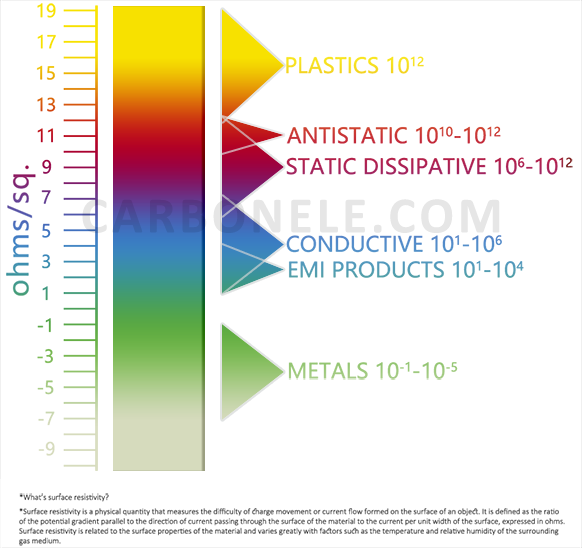
Get to Know Carbon Fibers
The table presents key performance data of carbon fiber grades. T300, with a tensile strength of 3530 MPa and a tensile modulus of 230 GPa, has a relatively low tensile elongation at break of 1.5% and a body density of 1.76 g/cm³. As the grade increases, for example, T700S shows an enhanced tensile strength of 4900 MPa compared to T300, while maintaining the same tensile modulus but with a higher elongation at break of 2.1%. T800S and T1000G both have a tensile modulus of 294 GPa, and their tensile strengths are 5880 MPa and 6370 MPa respectively. T1100G stands out with the highest tensile strength of 7000 MPa and a tensile modulus of 324 GPa. Generally, with the increase in product grade, the tensile strength and modulus tend to rise, while the density remains relatively stable around 1.8 g/cm³.

How to Buy?
If you want to obtain information such as product specifications, performance, and price, choose a suitable product according to your own needs. Meanwhile, you can ask the manufacturer to provide samples for testing to ensure that the material meets your usage requirements. If you are interested in purchasing this composite material, please contact the manufacturer Carbon (Xiamen) New Material directly.
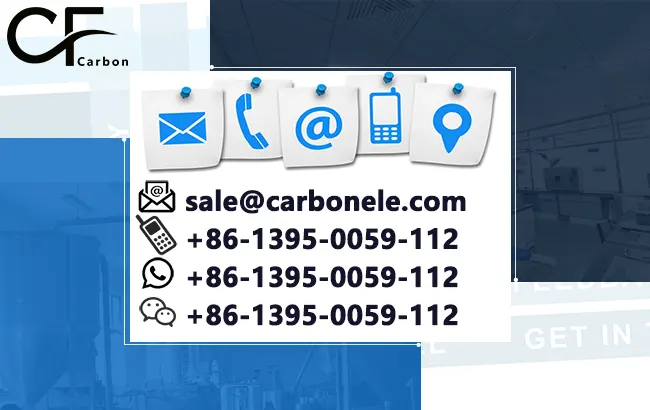
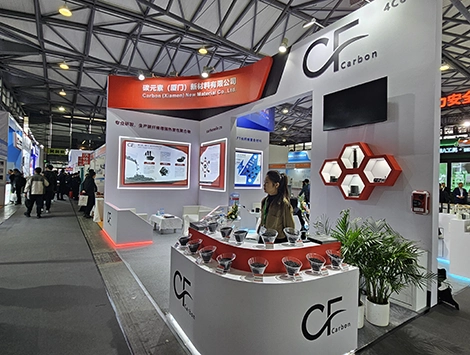

Frequently Asked Questions
Carbon (Xiamen) New Material Co., Ltd. aims to provide buyers with "one-stop" worry-free high-quality services. Here you can find all information about carbon fiber engineering plastics. If you still have questions, please send us an email for consultation!
-
How can I contact the manufacturer of a product that interests me?
When you find a product you are interested in, you can contact the manufacturer directly by sending an email and we will get back to you as soon as possible.
-
How do I find the products that interest me?
All you need to do is enter the keyword, product name in the search window and press the Enter key on your keyboard. Your search results page will then be displayed. You can also search within the product category pages on the home page. Each category is divided into subcategories, allowing you to refine your search and find products that interest you.
-
Where will I find a buying guide?
Please contact our after-sales service directly and we will provide you with a comprehensive operating guide.
-
What are CF Reinforced Thermoplastic Composites?
CF Reinforced Thermoplastic Composites are materials where carbon fibers are incorporated into a thermoplastic matrix. They combine the strength and stiffness of carbon fibers with the processability and recyclability of thermoplastics. For instance, they are used in automotive parts like bumper beams.
-
What are the benefits of CF Reinforced Thermoplastic Composites over traditional composites?
The key benefits include faster production cycles, easier recyclability, and better impact resistance. They also offer design flexibility. An example is in the manufacturing of consumer electronics casings where complex shapes can be achieved more easily.
-
How are CF Reinforced Thermoplastic Composites processed?
Common processing methods include injection molding, extrusion, and compression molding. Injection molding is widely used for mass production. For example, in the production of small components for the medical industry.
-
What industries use CF Reinforced Thermoplastic Composites?
They are utilized in aerospace, automotive, medical, and sports equipment industries. In aerospace, they can be found in interior components. In the medical field, they might be used in prosthetics.
-
How does the carbon fiber content affect the properties of the composites?
Higher carbon fiber content generally leads to increased strength and stiffness but may reduce ductility. A moderate content is often balanced for specific applications. For example, a higher content might be preferred in structural parts of a race car.
-
What are the challenges in using CF Reinforced Thermoplastic Composites?
Challenges include higher material costs, complex processing equipment requirements, and ensuring uniform fiber dispersion. Issues with adhesion between the fibers and the matrix can also arise. An example is in achieving consistent quality in large-scale production.







